
Supporting Oral Language in the Classroom: Educator Toolkit 1
Supporting Oral Language
in the Classroom:
Educator Toolkit
Created by: Dr. Caitlin Coughler and Dr. Lisa Archibald

Supporting Oral Language in the Classroom: Educator Toolkit 1
INTRODUCTION
Oral language is a crucial part of everyday interactions in a child’s life. Oral language
encompasses a variety of skills across five main areas: phonology, morphology, semantics,
syntax, and semantics.
To learn more about oral language skills, click here to access the LD@school article
Oral Language Skills and Learning Disabilities: A Review for Educators :
https://www.ldatschool.ca/oral-language-skills/
The importance of oral language skills to early literacy is briefly described in the
Ontario Human Rights Commission Right to Read report, where it was highlighted that,
“A comprehensive approach to early literacy recognizes that instruction that focuses
on word-reading skills, oral language development, vocabulary and knowledge
development, and writing are all important components of literacy.”
(Ontario Human Rights Commission, 2022, p. 5)
This toolkit provides strategies to support each strand of language comprehension in the
classroom. Each section includes detailed descriptions including the type of activity
(teacher or child-directed), when that activity can be used (before, during, or aer reading),
and examples for younger and older students. Specific activities and templates are provided.

Supporting Oral Language in the Classroom: Educator Toolkit 2
TABLE OF CONTENTS
3 Toolkit Legend
4 Choosing Reading Strategies to Support Oral Language Development
5 SECTION 1: Supporting Background Knowledge & Vocabulary
5 Graphic and Semantic Organizers
5 Semantic mapping
6 Example Semantic Maps
7 Concept/definition word mapping
7 Steps to word mapping
8 Word Mapping Examples
10 Semantic feature analysis
10 Steps for semantic feature analysis
11 SECTION 2: Supporting Language Structures
11 Teacher Talk
12 Talk Moves
13 Inferences
15 SECTION 3: Supporting Verbal Reasoning
15 Comprehension Monitoring
15 Question asking and answering
15 Periodic summaries
16 Think Alouds
16 Fix up strategies
17 SECTION 4: Supporting Literacy Knowledge
17 Before Reading
17 During reading
18 Aer Reading
18 Story Mapping
Appendix Charts
Blank Mind Map Template
Blank Word Mapping Template
Blank Inference Chart Template
Blank KWL Chart Template
Blank Conceptual Organizers Template
Blank Venn Diagrams Template
Blank Comparison Chart
Blank Sequential Organizer
Blank Story Mapping Template
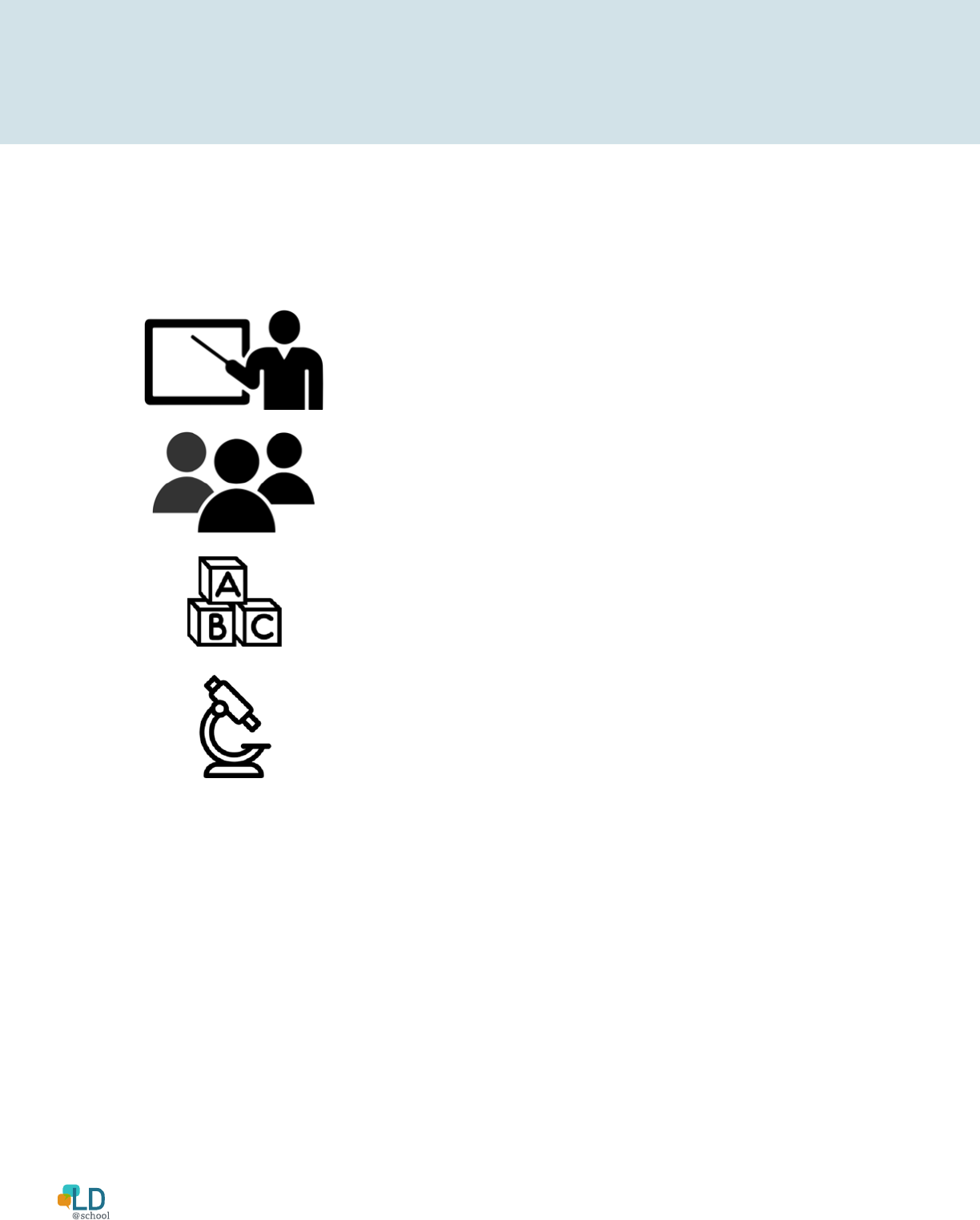
Supporting Oral Language in the Classroom: Educator Toolkit 3
TOOLKIT LEGEND
For each strategy the following images are included to provide details about the type of
activity (teacher or child-directed), the age (younger or older students), and when that
activity might be used (before, during or aer reading).
= teacher directed activities
= child directed activities
= activity for younger
elementary school- aged children
= performance expected for
older elementary – high school-aged children
B = before reading strategy
D = during reading strategy
A = aer reading strategy
* Many of the activities described support multiple strains in the language
comprehension branch of Scarborough’s Reading Rope (Scarborough, 2001)

Supporting Oral Language in the Classroom: Educator Toolkit 4
Choosing Reading Strategies to Support
Oral Language Development
Use the chart below to choose the appropriate activity to support
the development of oral language skills during reading exercises.
Before Reading Strategies During Reading Strategies Aer Reading Strategies
Probing
Questions
for Students
Why am I reading this?
What do I already know?
What do I think
I will learn?
What was that
part about?
What does that
word mean?
What do I think of
what I read?
What happened
in the text?
General
Purpose
Purpose & Overview Summarize so far & monitor
comprehension
Reflect & summarize
what was learned
Background
Knowledge
Activate prior knowledge
about topic that will help
with understanding
• brainstorm about topic
• use probing questions
• Semantic organizers
Semantic organizers Semantic organizers
Vocabulary
Knowledge
• Pre-teach and review
vocabulary
• Semantic organizers
(e.g., semantic mapping)
While reading have children
mark unfamiliar words
• Decode together
• Look at root of word (think
about prefix/suix)
Semantic organizers
(e.g., concept/word mapping)
• Semantic organizers
(e.g., semantic feature
analysis) to explore
related vocabulary
Language
Structures
• Teacher talk • Teacher talk
• Talk moves
• Teacher talk
• Talk moves
Verbal
Reasoning
• Predict: “I think this text is
going to be about…”
• Hypotheses to test as read
• Use title/cover and key
vocabulary
• Think aloud
• Inference instruction
(e.g., INFER strategy)
• Integrate background
knowledge (information
from text, information from
you, inference)
• Periodic summaries
• Think aloud
• Think aloud
• Use graphic organizers to
summarize important
information
• KW L
• Concept maps
• V enn diagrams
Literacy
Knowledge
• Discuss features of text
(e.g., title, headings, layout,
tables, graphs) & overview
(what is the text about?)
• Discuss the structure of the
text and what to expect while
reading
• Compare/contrast
• Cause/eect
• Problem/solution
• Timeframe/timelines
• Oral summaries: on the fly
comprehension checks
• Visual summaries:
• Compare/contrast:
Venn diagram
• Cause/effect and
problem/solution:
hierarchical
• Time order:
timeline
• Description: webs
• Sequence and summarize
(based on text type)
• Storylines/story
mapping
• Flow charts
• Cause-eect charts

Supporting Oral Language in the Classroom: Educator Toolkit 5
SECTION 1: Supporting Background Knowledge & Vocabulary
Graphic and Semantic Organizers BDA
One approach to support background knowledge and vocabulary instruction is to use
graphic and semantic organizers, where students represent graphically (write or draw)
the meanings and relationships of ideas and words in text.
Research has shown using semantic organizers supports improvements in reading
comprehension (Kim et al., 2004; National Reading Panel, 2000). Some examples of semantic
organizers include semantic mapping, word mapping, and semantic feature analysis.
Semantic mapping
A relationship map or web used to make predictions
about how vocabulary or concepts are connected.
Steps to creating a semantic map
(adapted from Toms-Bronowski, 1982; Vaughn & Edmonds, 2006):
1. Select a word or topic that is central to a story you will be reading or a topic
for future discussion.
2. Write the word on the board or chart.
3. Ask class to think of as many words as they can that relate to the word.
4. In small groups or as a whole class have students sort the brainstorm list
into categories and label the categories (reviewing together).
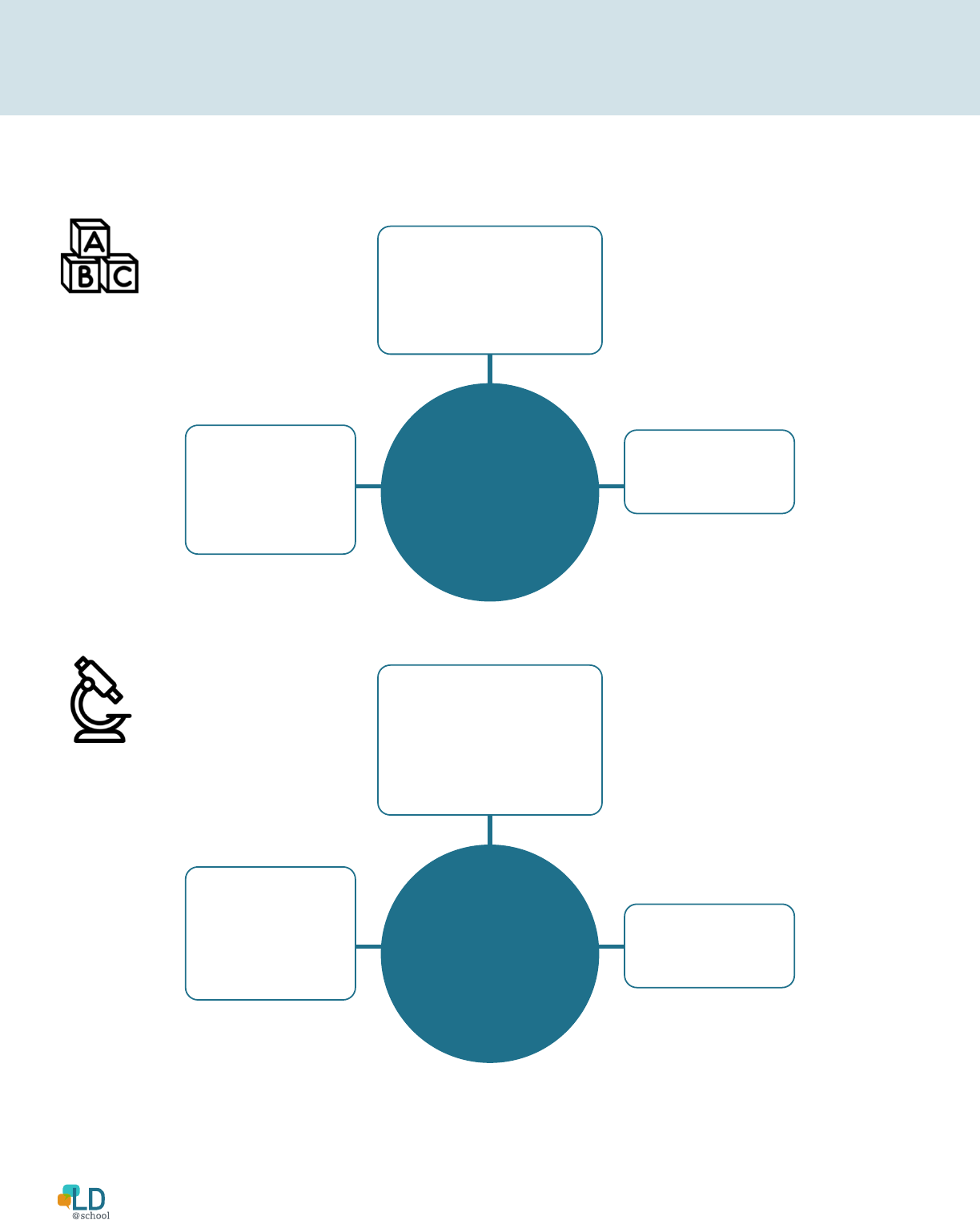
Supporting Oral Language in the Classroom: Educator Toolkit 6
SECTION 1: Supporting Background Knowledge & Vocabulary
Example Semantic Maps:
CAT
Things they eat
• mice
• milk
• canned food
or tuna
Things they do
• climb
• purr
What they look like
• furry
• whiskers
• claws
• stripes
WEATHER
Precipitation
• drizzle
• rain
• snow
• graupel
Temperature
• wind child
• heat index
Clouds
• cumulus
• cirrus
• alto
• nimbus
• stratus
Blank Mind Map Template - Click HERE

Supporting Oral Language in the Classroom: Educator Toolkit 7
SECTION 1: Supporting Background Knowledge & Vocabulary
Concept/definition word mapping
Extends the understanding of concepts encouraging students
to think of how they are defined and their characteristics.
Steps to word mapping
(adapted from Rupley & Dee Nichols, 2005; Rosenbaum, 2001):
1. Introduce students to what they will learn, why it is important,
and what they will be doing.
2. Introduce word map using a large version with concrete examples,
with students following on a smaller version
3. Explain each part
4. Model how to organize information using think alouds
5. Once students understand, they can complete it independently,
mapping given words and words of their choice
Blank Word Mapping Template - Click HERE

Supporting Oral Language in the Classroom: Educator Toolkit 8
Comparison Dierent
(Antonym)
Comparison Same/Similar
(Synonym)
Slow
Quick
Properties (What is it like?)
Moving at high speed
Association
(group/category; What is it like?)
New word (page number) Other forms of word
Fast
faster
fastest
Sentence from book
Johnny ran as fast as he could.
My own sentence
Cheetahs run fast
My example/drawing of it
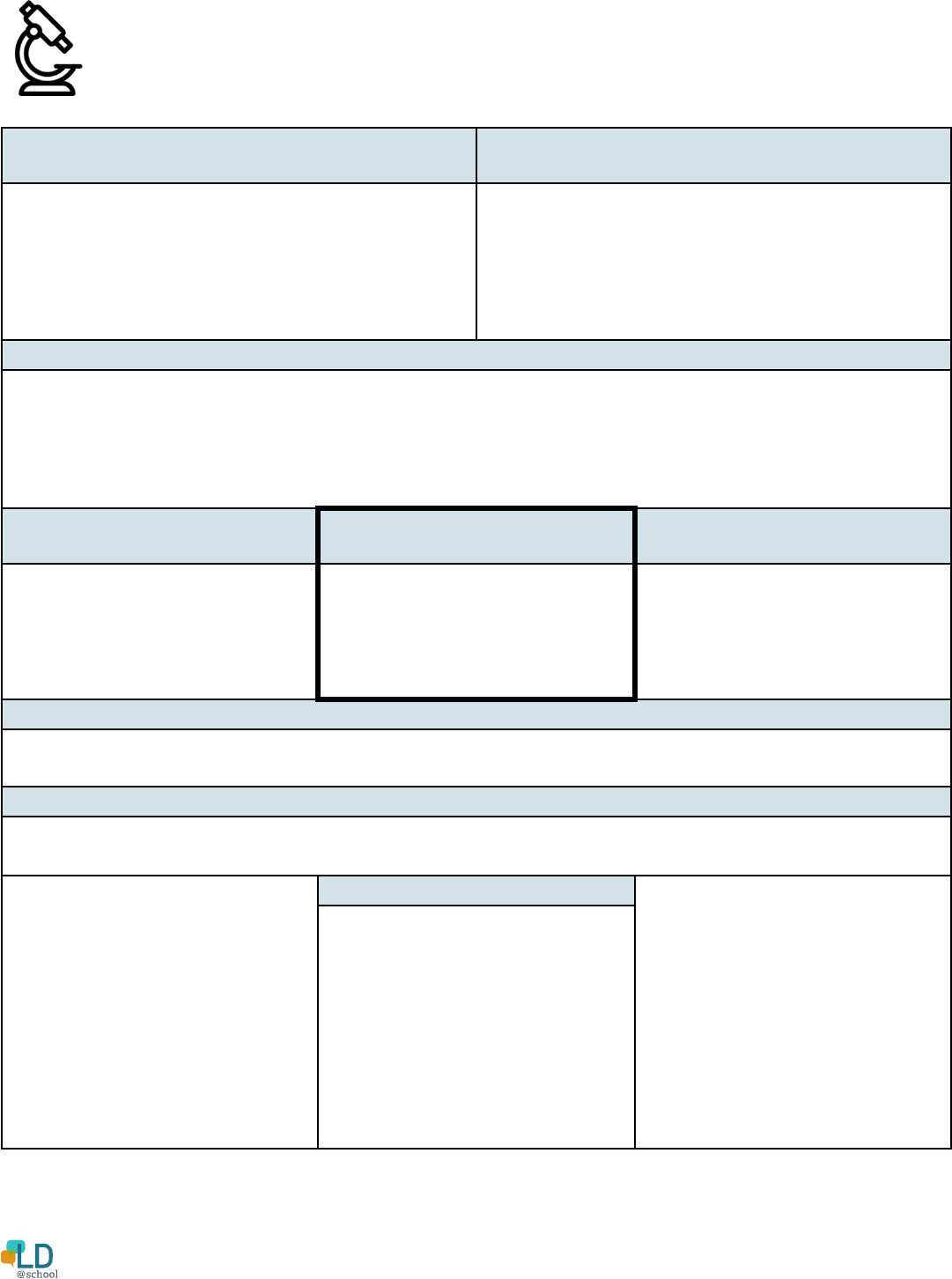
Supporting Oral Language in the Classroom: Educator Toolkit 9
Comparison Dierent
(Antonym)
Comparison Same/Similar
(Synonym)
1) Casual clothes
2)
3) Lever- mechanism also used in
machinery
1) Uniform
2) Supplies
3) Magnetic components used in
electric motors
Properties (What is it like?)
1) Special protective clothing
2) Supplies
3) Circular, rotating mechanism that transmits torque
Association
(group/category; What is it like?)
New word (page number) Other forms of word
1) Clothing
2) Equipment
3) Machinery component
Gear
Gears
Gear-up
Sentence from book
He rotated the gear and the door creaked open.
My own sentence
They packed up their gear and felt prepared for their trip.
My example/drawing of it
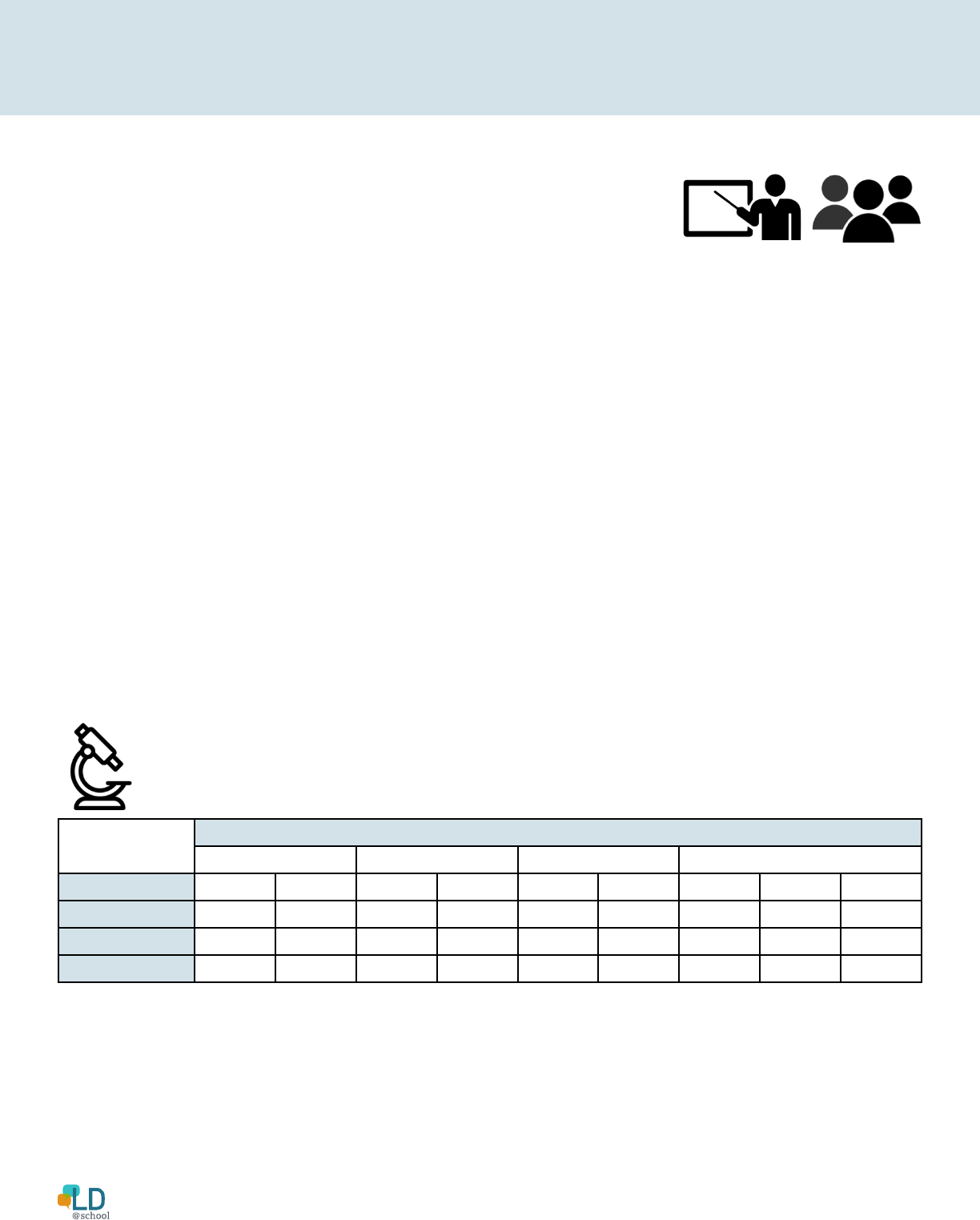
Supporting Oral Language in the Classroom: Educator Toolkit 10
SECTION 1: Supporting Background Knowledge & Vocabulary
Semantic feature analysis
Expands understanding of the relationship of words that
are related by class or common features by looking at the
ways words within a category are alike and dierent.
Steps for semantic feature analysis
(adapted from Toms-Bronowski, 1982; Rupley & Dee Nichols, 2005):
1. Select a topic.
2. List in le column words that relate to the topic.
3. List in top row features shared by some of the words in the column.
4. Have students look at the matrix of characteristics/defining features and determine
if each word in the column shares the features listed in the row using + for present
and - for absent.
5. Encourage students to add their own words and features.
6. Discuss with students the unique features of each word and the
relationship between the words and features
(as indicated by + and - in grid).
Features
Shape Colour Precipitation Location in Sky
Cloud Types Flat Puy White Dark Rainy Misty Low Middle High
Status
+ - + + - + + - -
Cumulus
- + + - - - + - -
Cirrus
+ - + - - - - - +

Supporting Oral Language in the Classroom: Educator Toolkit 11
SECTION 2: Supporting Language Structures
Teacher Talk BDA
The use of complex syntax in the classroom is linked with children’s
grammar and vocabulary learning (Farrow et al., 2020; Vasilyeva et al., 2006).
Using mental state verbs (e.g., think, know, hope, wonder) leads to more
complex syntax than action verbs (e.g., identify, write; Owen Van Horne et al., 2017).
Examples of mental state words: Example phrases:
Try Let’s try to find a match.
Know I know he is going to.
Think What do you think will happen next?
Wonder I wonder what will happen next.
Remember Remember to hang up your coat first.
Understand If you don’t understand what to do raise your hand.
Forget Don’t forget to write your name.
For struggling learners break up the complex sentences:
e.g., if you say “I wonder if this will fall now”
• Then say and gesture: “I’m wondering” and “this might fall”
• Using support of gestures (pointing) and pictures can support understanding
Seemingly small changes in the way that teachers communicate and present information in their classrooms
can have huge impacts for children with developmental language disorder (DLD), a persistent problem
learning language. Some easy to implement changes can be represented by the acronym S.M.A.R.T
(adapted from Mentrasti, 2019).
For more information, click here to access the LD@school article Oral Language Skills and
Learning Disabilities: A Review for Educators https://www.ldatschool.ca/oral-language-skills/.

Supporting Oral Language in the Classroom: Educator Toolkit 12
SECTION 2: Supporting Language Structures
Talk Moves BDA
Talk moves are sentence starter phrases that help students speak, listen, and expand on
each other’s ideas, increasing verbal participation in class. One potential expansion on the
starter phrases alone is to add corresponding hand signals. These hand signals help you
to quickly identify who is engaged within the discussion. These signals also support
facilitation of discussions, as you can quickly see who has information they would like
to add, who agrees with what has been said and who disagrees.
Classroom Talk moves may include:
(Adapted from Smekens Education Solutions Inc., 2018)
Feedback Hand Signal Sentence starter phrase
Repeating another student’s point
“I can summarize”
Adding on
“I would like to add to that”,
“Adding onto what __ said __”
Clarifying
“Let me see if I understand what you
are saying __”,
“Can you say more about that?”
Agree
“I agree with__”
Disagree
“I respectfully disagree because__”
To view more examples of Talk Moves go to:
https://www.smekenseducation.com/wp-content/uploads/2020/06/Talk_Moves_SMEKENS.pdf
See https://www.smekenseducation.com/require-students-to-listen-during-conversations-with-talk-moves/
for more videos describing talk moves and handouts.
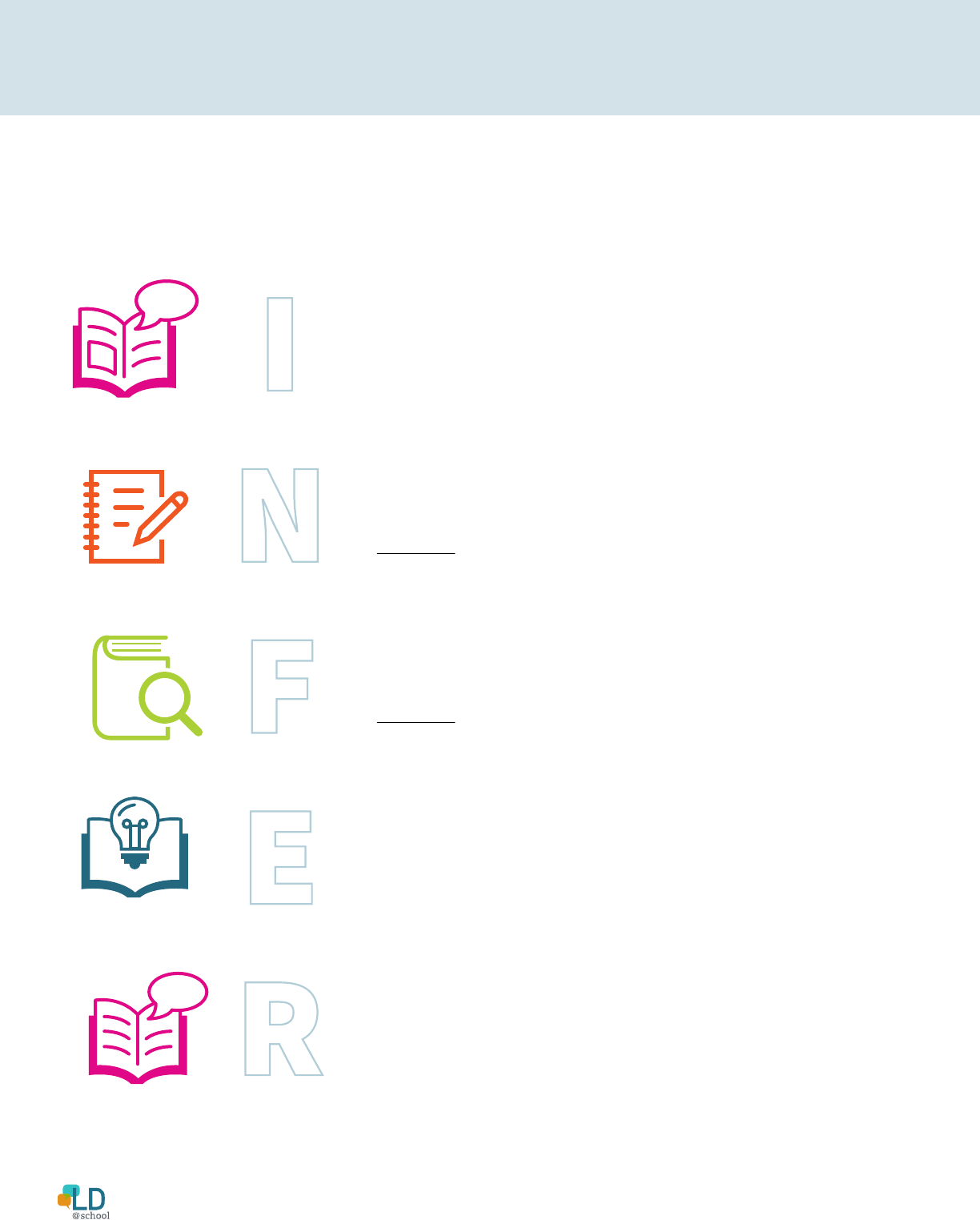
Supporting Oral Language in the Classroom: Educator Toolkit 13
SECTION 3: Supporting Verbal Reasoning
Inferences BDA
One method of inference instruction outlined by Fritschmann et al., 2007
uses the mnemonic INFER:
Interact with the passage and questions
• Preview passage
• Read questions
• Identify if questions are 1) fact questions or 2) “think and see”
(inferential) questions (i.e., purpose, main idea/summarization,
prediction or clarification questions)
Note what you know
• Active related background knowledge or experiences
• Underline key words in questions
Find the clues
• Carefully read passage
• Underline clues related to keywords in questions
• Create tentative answers to the questions
Explore more details
• Look for additional clues that support tentative answers
Return to the question
• Check that an answer has been selected for each question
?
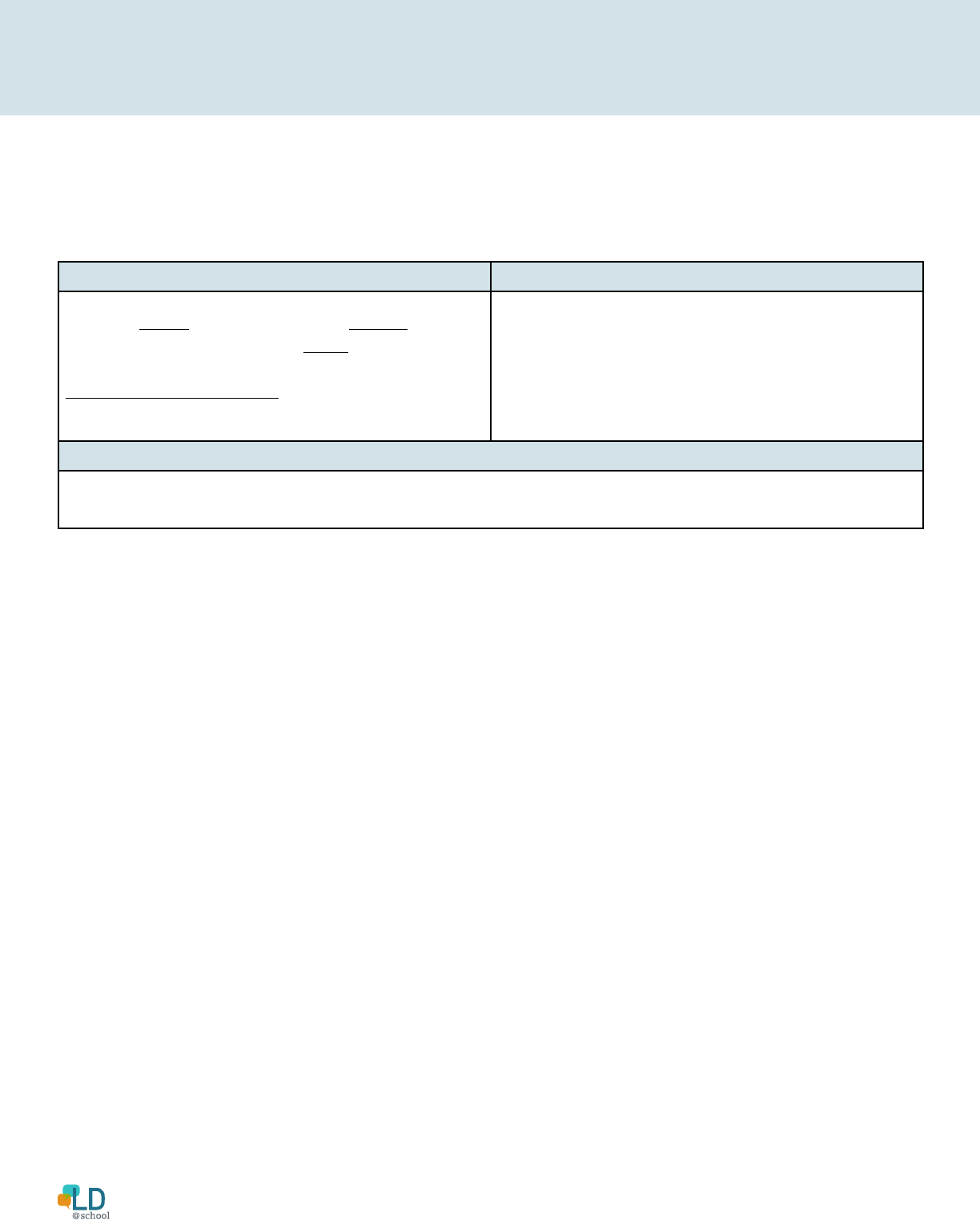
Supporting Oral Language in the Classroom: Educator Toolkit 14
SECTION 3: Supporting Verbal Reasoning
One way to explicitly help students activate their background knowledge is to use a chart
like below where students think about information they know and practice integrating it
with information from the text:
Information from text Information from you
Billy was crying. His whole day was spoiled. All his
work had been broken by the wave. His mother
came to stop him crying. But she accidentally
stepped on the only tower that was le. Billy cried
even more.
Beaches have sand and waves
Inference
Billy was making sandcastles at the beach. The water washed them away.
Blank Inference Chart Template - Click HERE

Supporting Oral Language in the Classroom: Educator Toolkit 15
SECTION 3: Supporting Verbal Reasoning
Comprehension Monitoring BDA
(Neufeld, 2005):
Question asking and answering
◆ Teach students how to students how to use question asking and answering
to support their comprehension
Before reading:
◆ Clarify purpose for reading:
• Why am I reading this?
• What do I already know?
• What do I think I will learn?
◆ Overview text:
• What is it about?
◆ Make predictions:
• I think this text is going to be about…
• In this chapter I think I will learn…
During & After reading:
• What was that part about?
• What does that word mean?
◆ Check for understanding
• Is what I read clear?
• Can I answer who, what, when, where, and why questions about the text?
• What happened in the story?
Periodic summaries DA
◆ Summarize main idea: stop and restate the main ideas/points
• Oral, written or visual summaries
■ KWL chart (3 columns: What I know,
What I want to learn, What I learned)
■ Conceptual organizers
■ Venn diagrams

Supporting Oral Language in the Classroom: Educator Toolkit 16
SECTION 3: Supporting Verbal Reasoning
Think Alouds BDA
◆ Model your thinking, this can be before reading, during reading or after reading
◆ This is especially important at points that may be confusing for the student,
such as new words or strange sentence construction
An example of a think aloud modelled by the teacher:
“I wonder who this book is going to be about?” I haven’t read this book before, so
I don’t know for sure who it is about. But I can use hints from the cover to guess
who the book might be about. There is a picture of a bear and a bird on the
cover, so maybe the book is about the bird or the bear, or maybe about both.
But, I’d have to read the book to find out if I made a good guess or not”
(Van Kleeck & Schwarz, 2011, p. 34)
Fix up strategies (when don’t understand)
DA
◆ Re-read part or all of text
◆ Look ahead
◆ Stop and relate information to what already know about topic
◆ Seek help
Blank KWL Chart Template - Click HERE
Blank Conceptual Organizers Template - Click HERE
Blank Venn Diagrams Template - Click HERE
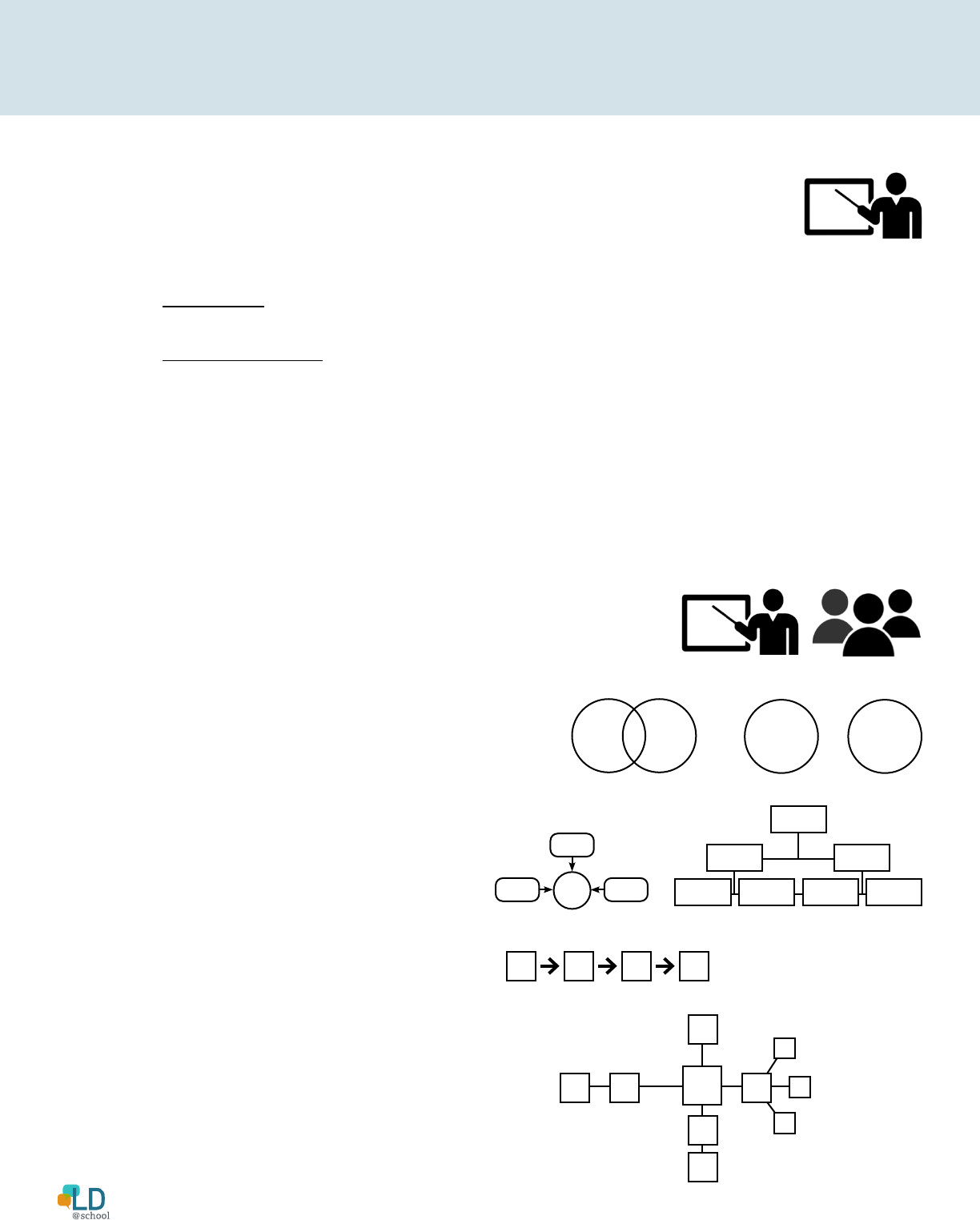
Supporting Oral Language in the Classroom: Educator Toolkit 17
SECTION 4: Supporting Literacy Knowledge
Before reading:
Discuss features of text (e.g., title, headings, layout, tables, graphs)
Explicitly teach text structure, this differs based on the type of text:
◆ For narratives discuss story grammar structure: character, setting, problem,
action, ending/resolution
◆ For expository texts discuss the structure of the text (how text is organized) and
what to expect while reading (e.g., keywords associated with that text structure)
• Compare/contrast
■ However, but, not only, similarly, unless
• Cause/effect & problem/solution
■ Because, since, as a result of, if/then, therefore
• Timeframe/timelines
■ On __, before, after, soon, later, following
During reading:
◆ Oral summaries: on the fly comprehension checks
◆ Visual summaries:
• Compare/contrast: Venn diagram
Blank Venn Diagram Template
Blank Comparison Chart Template
• Cause/effect and problem/solution: hierarchical
Conceptual Organizer Template
• Time order: timeline
Sequential Organizer Template
• Description: webs (i.e., semantic mapping)
A
B
vs

Supporting Oral Language in the Classroom: Educator Toolkit 18
SECTION 4: Supporting Literacy Knowledge
After reading:
◆ Sequence and summarize (based on story type)
• Storylines or story mapping (see below)
• Flow charts
• Cause-effect charts
Story Mapping Example:
Setting/Time: Woods, in bears’ house
Main Character(s): Goldilocks, Mama bear, Papa bear, and Baby bear
Episode(s):
Problem Solution Outcome
Goldilocks thought the chair
was too hard
She tried another chair She broke the chair when
she sat on it
Reaction: Papa and Mama bear were very angry when they got home, Baby bear was sad
that his chair was broken
Theme (Main idea): (1) Respect the privacy and property of others,
(2) How your actions can hurt others
Additional free graphic and visual organizers available online:
https://thinkport.org/graphic-organizers.html
https://my.hrw.com/nsmedia/intgos/html/igo.htm
https://www.hmhco.com/blog/free-graphic-organizer-templates
Blank Story Mapping Template - Click HERE
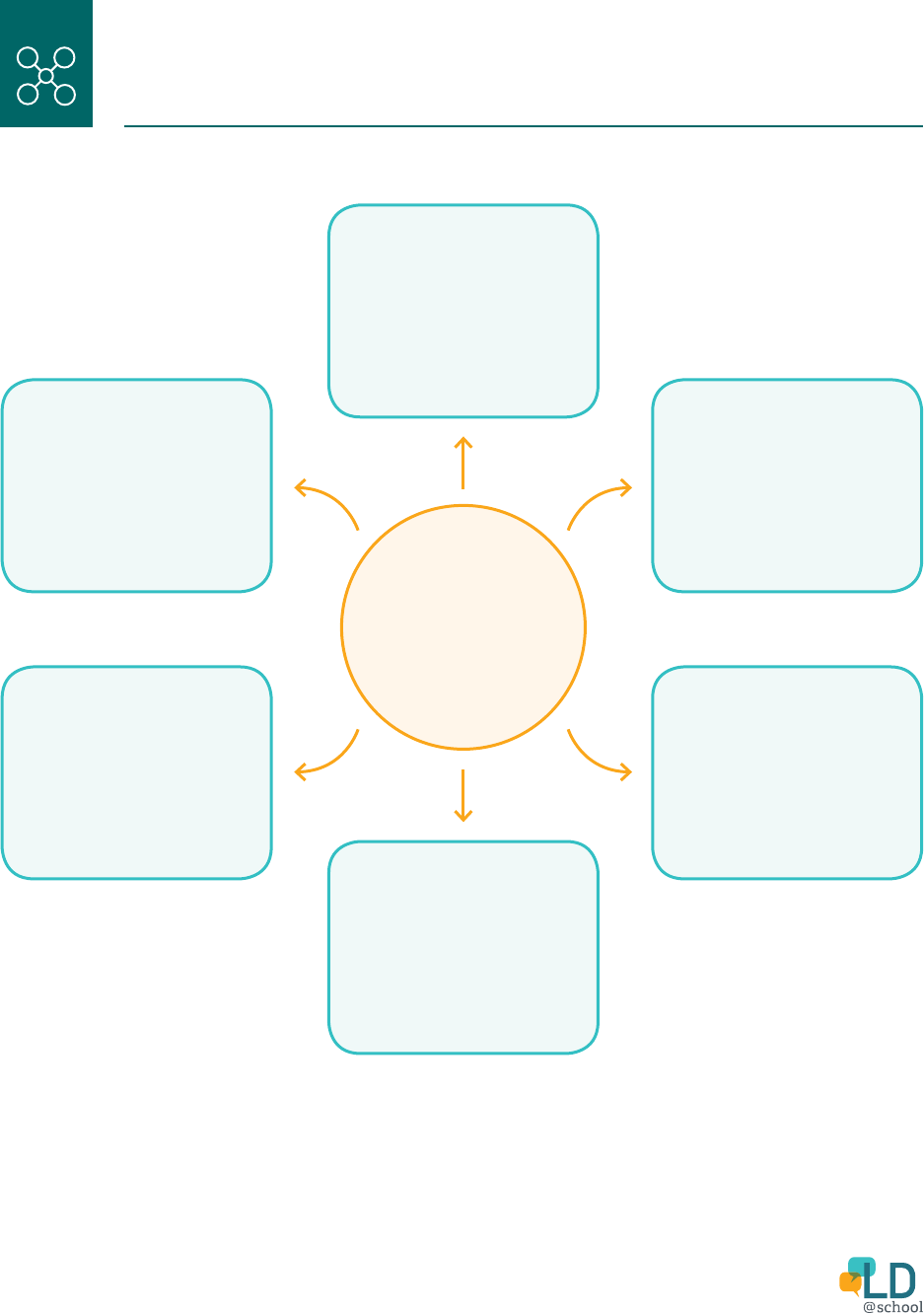
Mind Map
Notes:
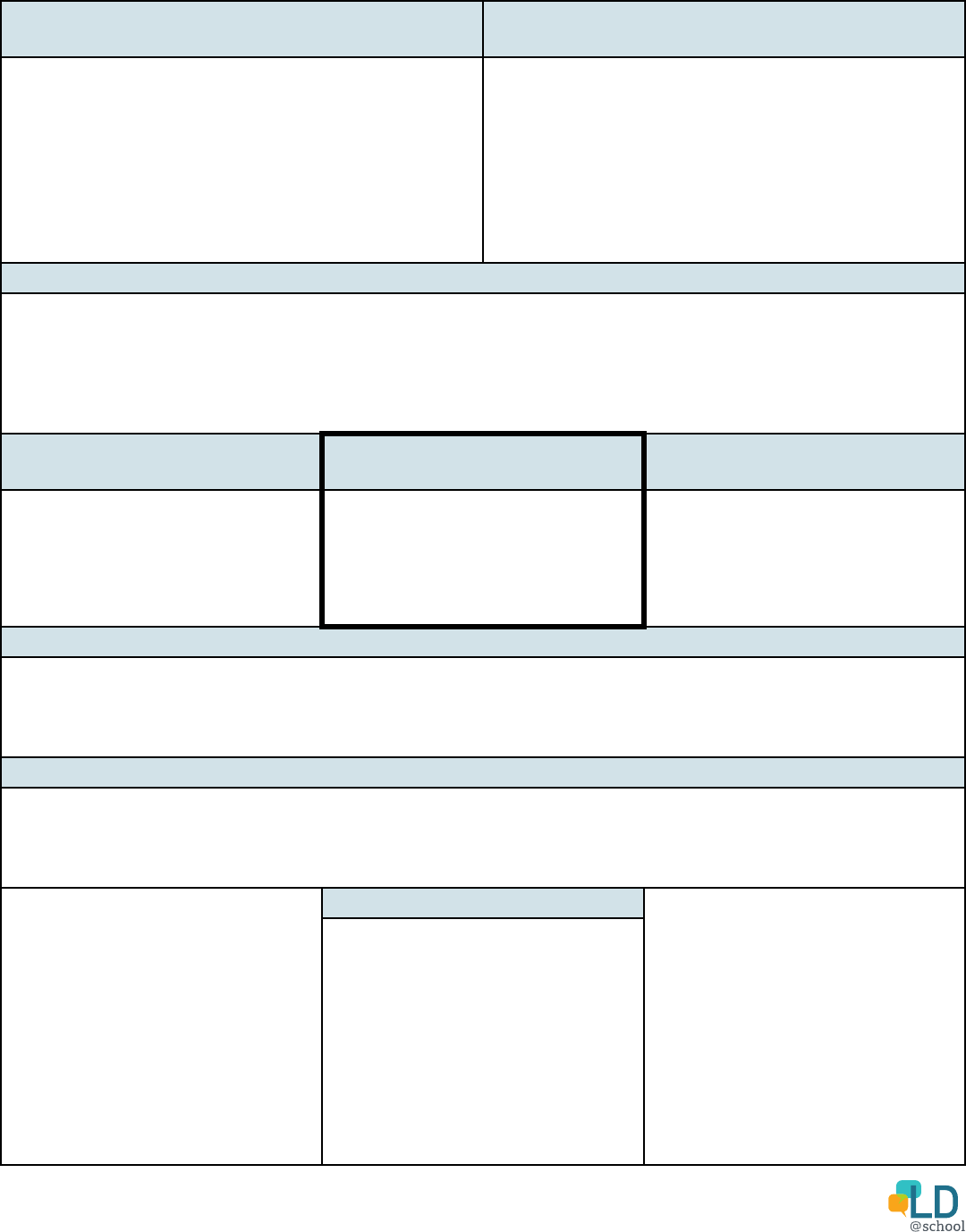
Comparison Dierent
(Antonym)
Comparison Same/Similar
(Synonym)
Properties (What is it like?)
Association
(group/category; What is it like?)
New word (page number) Other forms of word
Sentence from book
My own sentence
My example/drawing of it
Word Mapping

Inference Chart
Information from text Information from you
Inference
Information from text Information from you
Inference
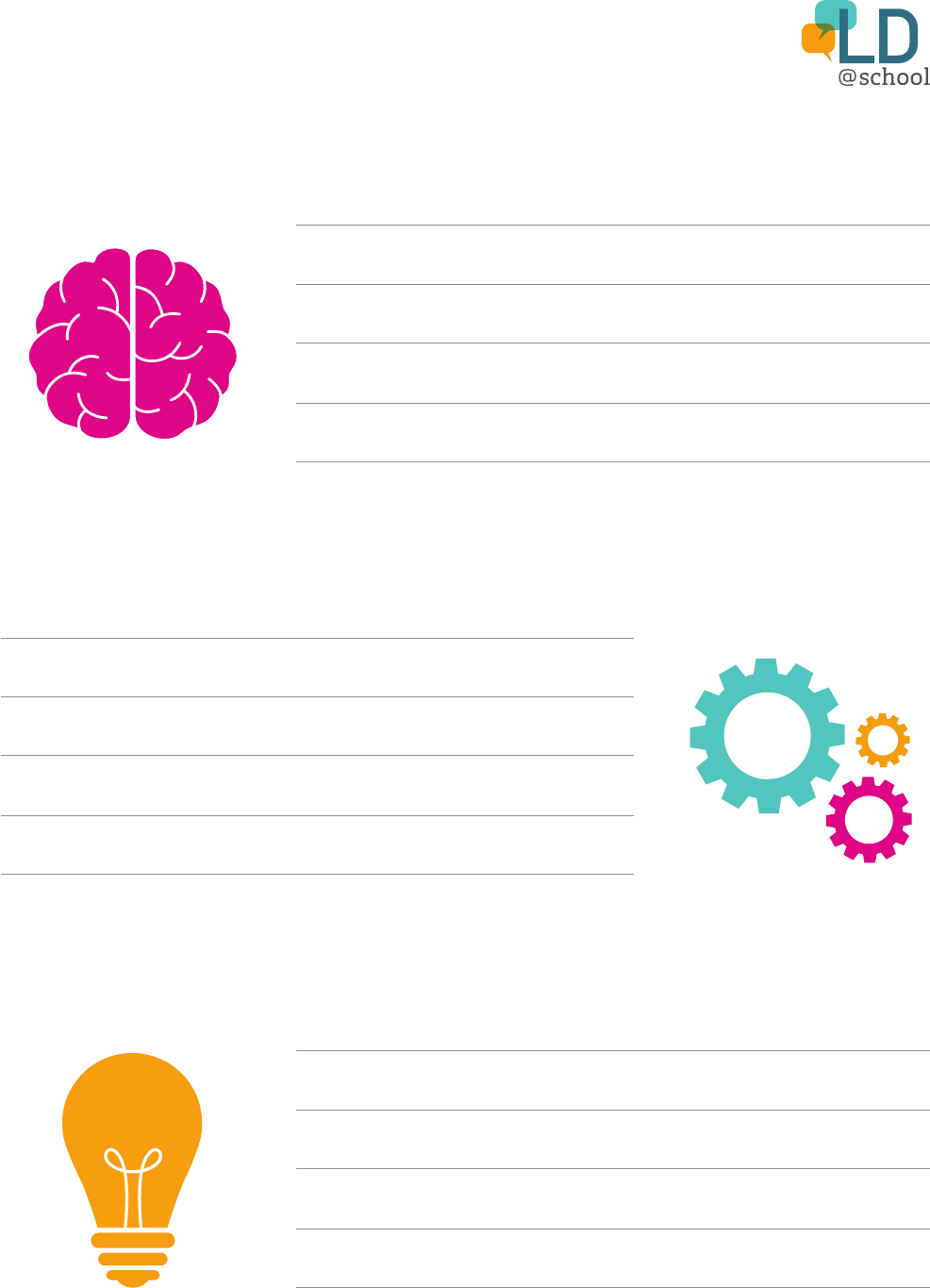
KWL Strategy
What I KNOW
W
hat I WANT to know
What I LEARNED
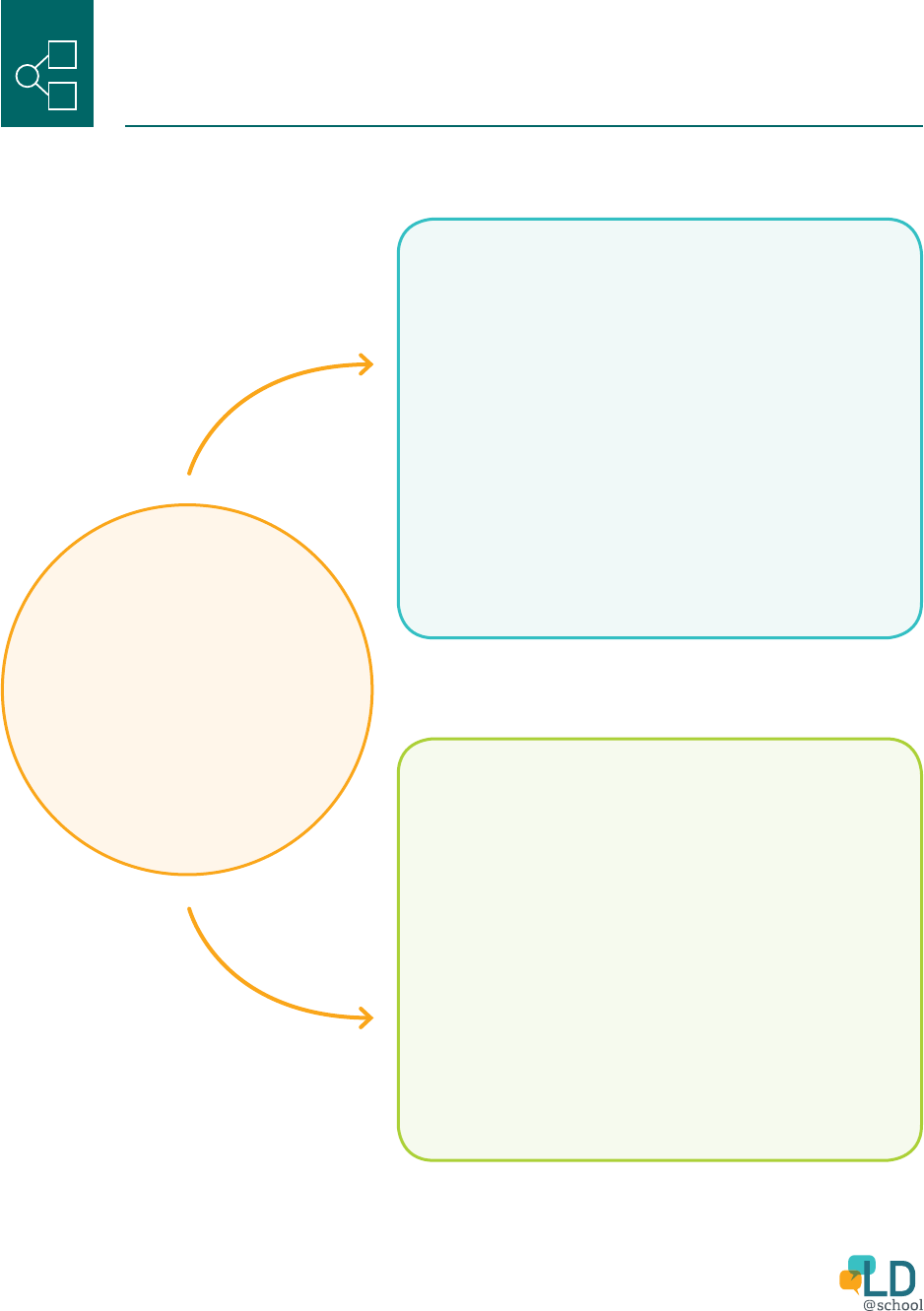
Conceptual Organizer
Topic/Problem:
Causes:
Eects:

Venn Diagram
A: Vs. B:
Notes:
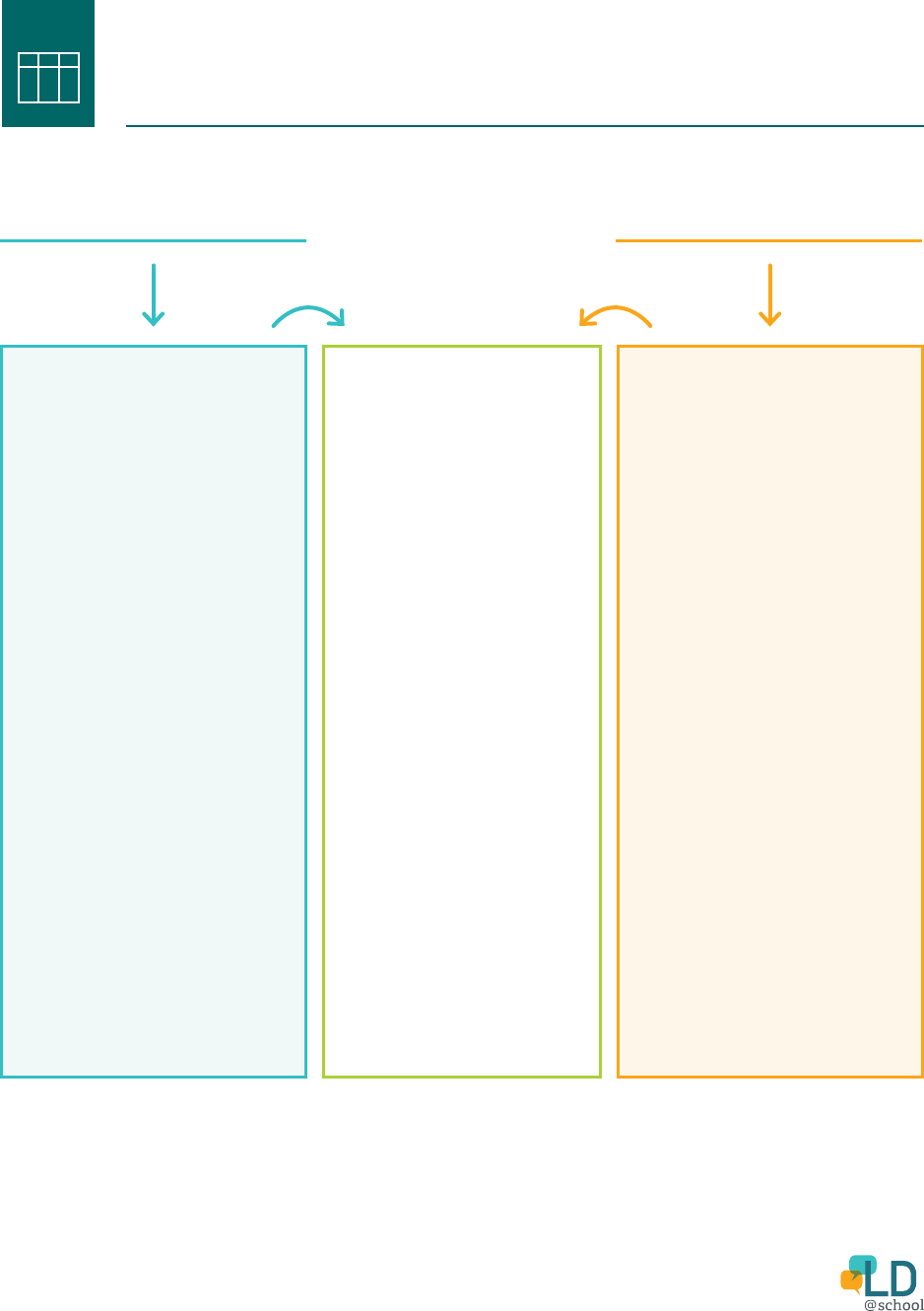
Comparison Chart
A: Vs. B:
Notes:
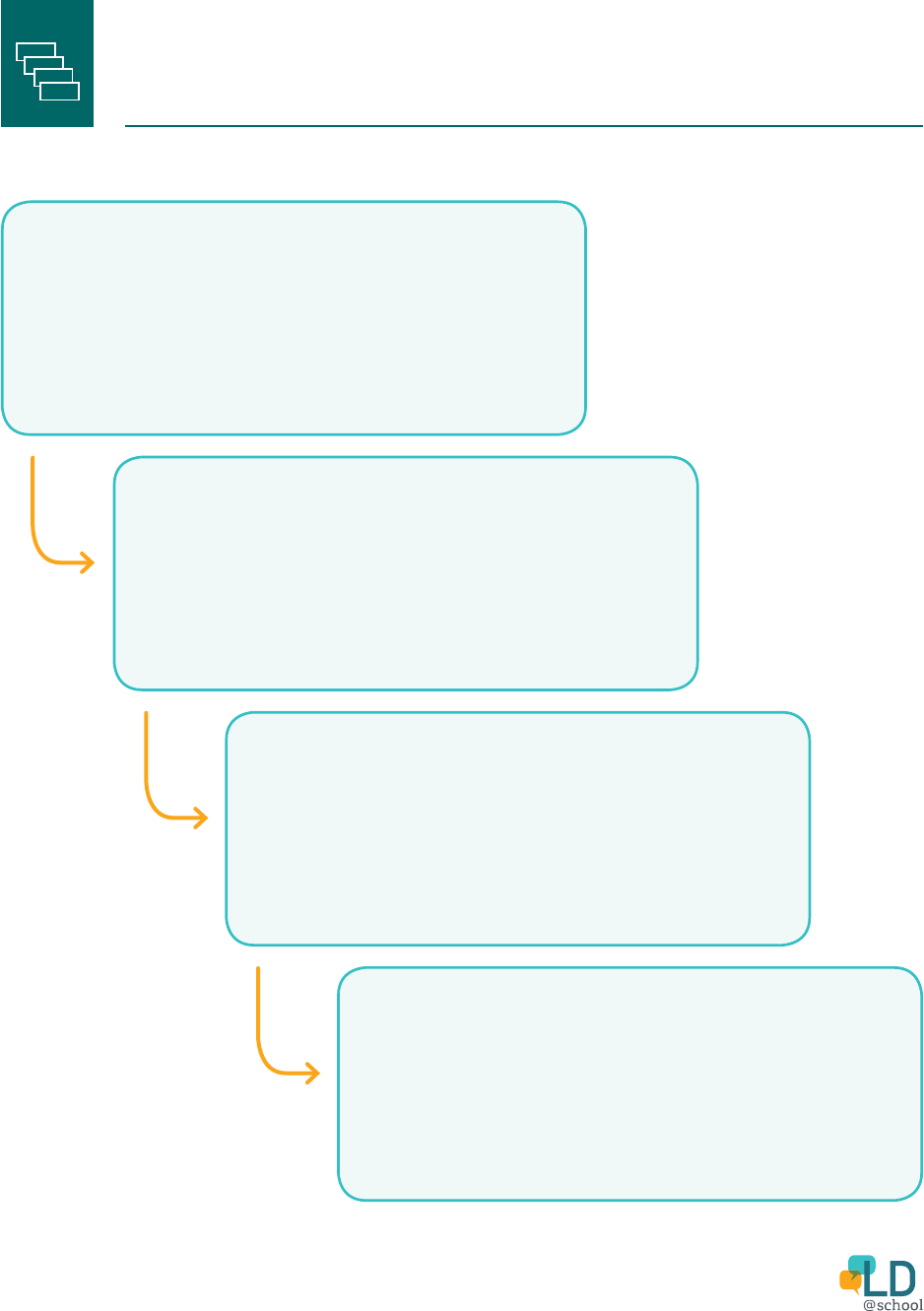
Sequential Organizer
First:
Next:
Then:
Lastly:

Setting/Time:
Main Character(s):
Episode(s):
Problem Solution Outcome
Reaction:
Theme (Main idea):
Story Mapping
